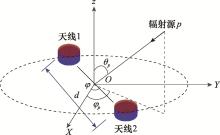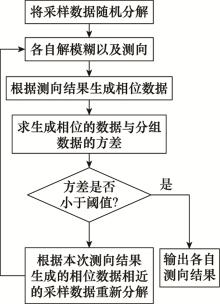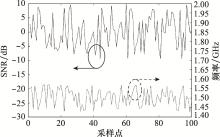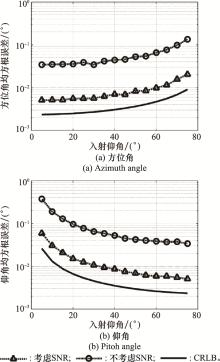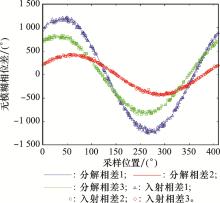Systems Engineering and Electronics ›› 2022, Vol. 44 ›› Issue (2): 420-426.doi: 10.12305/j.issn.1001-506X.2022.02.08
• Electronic Technology • Previous Articles Next Articles
DOA estimation of multiple time-varying signals with expectation-maximization algorithm
Baohua FAN1, Le ZUO1,*, Yong TANG1,2, Zehua HU1
- 1. The 29th Institute of China Electronics Technology Group Corporation, Chengdu 610036, China
2. School of Electronic Science and Engineering, University of Electronic Science and Technology of China, Chengdu 611731, China
-
Received:2021-02-15Online:2022-02-18Published:2022-02-24 -
Contact:Le ZUO
CLC Number:
Cite this article
Baohua FAN, Le ZUO, Yong TANG, Zehua HU. DOA estimation of multiple time-varying signals with expectation-maximization algorithm[J]. Systems Engineering and Electronics, 2022, 44(2): 420-426.
share this article
| 1 | JOHNSON D H , DUDGEON E . Array signal processing: concepts and techniques, signal processing series[M]. New Jersey: Prentice-Hall, 1993. |
| 2 | PILLAI S U . Array signal processing[M]. New York: Springer-Verlag, 1989. |
| 3 | HAYKIN S S . Array signal processing[M]. New Jersey: Prentice Hall, 1985. |
| 4 | KAWI Y , LIU W , XIAO F . The review of radio science[M]. New York: IEEE Press, 2002. |
| 5 |
KRIM H , VIBERG M . Two decades of array signal processing research: the parametric approach[J]. IEEE Signal Processing Magazine, 1996, 13, 67- 94.
doi: 10.1109/79.526899 |
| 6 |
FRIEDLANDER B , ZEIRA A . Eigenstructure-based algorithms for direction finding with time-varying arrays[J]. IEEE Trans.on Aerospace and Electronic Systems, 1996, 32 (2): 689- 701.
doi: 10.1109/7.489512 |
| 7 | SHEINVALD J , WAX M . Direction finding with fewer receivers via time-varying preprocessing[J]. IEEE Trans.on Signal Processing, 2002, 47 (1): 2- 9. |
| 8 | HANSEN R C . Phased array antennas, second edition[M]. New Jersey: Wiley, 2009. |
| 9 |
恽小华, 王莉, 恽才华, 等. 基于最大似然算法的空间谱估计测向性能分析[J]. 电子学报, 1996, 24 (12): 70- 72.
doi: 10.3321/j.issn:0372-2112.1996.12.015 |
|
YUN X H , WANG L , YUN C H , et al. Direction finding properties analysis of signal spectrum estimation basing on the maximum likelihood method[J]. ACTA Electronica Sinica, 1996, 24 (12): 70- 72.
doi: 10.3321/j.issn:0372-2112.1996.12.015 |
|
| 10 | DEMPSTER A P . Maximum likelihood estimation from incomplete data via the EM algorithm[J]. Journal of the Royal Statistical Society, 1977, 39 (1): 1- 38. |
| 11 |
FEDER M , WEINSTEIN E . Parameter estimation of superimposed signals using the EM algorithm[J]. IEEE Trans.on Acoustics, Speech, and Signal Processing, 1988, 36 (4): 477- 489.
doi: 10.1109/29.1552 |
| 12 | CHUNG P J , BOHME J F , HERO A O . Tracking of multiple moving sources using recursive EM algorithm[J]. Journal on Applied Signal Processing, 2005, 2005 (1): 50- 60. |
| 13 |
FRENKEL L , FEDER M . Recursive expectation-maximization (EM) algorithms for time-varying parameters with applications to multiple target tracking[J]. IEEE Trans.on Signal Processing, 1999, 47 (2): 306- 320.
doi: 10.1109/78.740104 |
| 14 |
MADA K , WU H C , IYENGAR S S . Efficient and robust EM algorithm for multiple wideband source localization[J]. IEEE Trans.on Vehicular Technology, 2009, 58 (6): 3071- 3075.
doi: 10.1109/TVT.2009.2012495 |
| 15 |
LU L , WU H C . Robust expectation-maximization direction-of-arrival estimation algorithm for wideband source signals[J]. IEEE Trans.on Vehicular Technology, 2011, 60 (5): 2395- 2400.
doi: 10.1109/TVT.2011.2138174 |
| 16 |
AUTREY S W . Passive synthetic arrays[J]. Journal of the Acoustical Society of America, 1988, 84 (2): 592- 598.
doi: 10.1121/1.396837 |
| 17 |
SHEINVALD J , WAX M , MEISS A J . Localization of multiple sources with moving arrays[J]. IEEE Trans.on Signal Processing, 1998, 46 (10): 2736- 2743.
doi: 10.1109/78.720375 |
| 18 | KENDRA J R . Motion-extended array synthesis-Part I: Theory and method[J]. IEEE Trans.on Geoscience & Remote Sensing, 2017, 55 (4): 2028- 2044. |
| 19 |
STERGIOPOULOS S , URBAN H . A new passive synthetic aperture technique for towed arrays[J]. IEEE Journal of Oceanic Engineering, 1992, 17 (1): 16- 25.
doi: 10.1109/48.126950 |
| 20 |
YEN N . A circular passive synthetic array: an inverse problem approach[J]. IEEE Journal of Oceanic Engineering, 1992, 17 (1): 40- 47.
doi: 10.1109/48.126953 |
| 21 | KAWASE S . Radio interferometer for geosynchronous-satellite direction finding[J]. IEEE Trans.on Aerospace & Electronic Systems, 2007, 43 (2): 443- 449. |
| 22 |
LAN X , WAN L , HAN G . Novel DOA estimation algorithm using array rotation technique[J]. Future Internet, 2014, 6 (1): 155- 170.
doi: 10.3390/fi6010155 |
| 23 |
李腾, 郭福成, 姜文利. 星载干涉仪无源定位新方法及其误差分析[J]. 国防科技大学学报, 2012, 34 (3): 164- 170.
doi: 10.3969/j.issn.1001-2486.2012.03.032 |
|
LI T , GUO F C , JIANG W L . A novel method for satellite-borne passive localization using interferometer and its error analysis[J]. Journal of National University of Defense Technology, 2012, 34 (3): 164- 170.
doi: 10.3969/j.issn.1001-2486.2012.03.032 |
|
| 24 | BERGH F V D, ENGELBRECHT A P. A new locally convergent particle swarm optimiser[C]//Proc. of the IEEE International Conference on Systems, Man and Cybernetics, 2003. |
| 25 |
陈鑫, 刘振, 魏玺章. 基于旋转均匀圆阵的单近场源参数估计解模糊算法[J]. 电子学报, 2017, 45 (3): 584- 590.
doi: 10.3969/j.issn.0372-2112.2017.03.012 |
|
CHEN X , LIU Z , WEI E Z . Ambiguity resolving in parameter estimation of a single near-field source via rotating uniform circular array[J]. ACTA Electronica Sinica, 2017, 45 (3): 584- 590.
doi: 10.3969/j.issn.0372-2112.2017.03.012 |
|
| 26 |
张敏, 郭福成, 李腾, 等. 旋转长基线干涉仪测向方法及性能分析[J]. 电子学报, 2013, 41 (12): 2422- 2429.
doi: 10.3969/j.issn.0372-2112.2013.12.016 |
|
ZHANG M , GUO F C , LI T , et al. A direction finding method and analysis based on the rotated long baseline interferometer[J]. ACTA Electronica Sinica, 2013, 41 (12): 2422- 2429.
doi: 10.3969/j.issn.0372-2112.2013.12.016 |
|
| 27 | 张敏, 郭福成, 周一宇, 等. 时变长基线2维干涉仪测向方法[J]. 电子与信息学报, 2013, 35 (12): 2882- 2888. |
| ZHANG M , GUO F C , ZHOU Y Y , et al. Direction finding method for two-dimension interferometer using the time varying long baseline[J]. Journal of Electronics & Information Technology, 2013, 35 (12): 2882- 2888. | |
| 28 |
LIU Z M , GUO F C . Azimuth and elevation estimation with rotating long-baseline interferometers[J]. IEEE Trans.on Signal Processing, 2015, 63 (9): 2405- 2419.
doi: 10.1109/TSP.2015.2405506 |
| 29 | 司伟建, 吴娜, 蓝晓宇. 基于阵列基线旋转的多目标DOA估计算法[J]. 系统工程与电子技术, 2014, 36 (5): 7- 13. |
| SI W J , WU N , LAN X Y . Multiple DOA estimation algorithm based on arrays rotation method[J]. Systems Engineering and Electronics, 2014, 36 (5): 7- 13. | |
| 30 | 申皓明, 廖桂生, 杨志伟. 基于旋转干涉仪的多目标参数估计[J]. 系统工程与电子技术, 2018, 40 (8): 6- 15. |
| SHEN H M , LIAO G S , YANG Z W . Rotating interferometer-based method for multiple objective parameter estimation[J]. Systems Engineering and Electronics, 2018, 40 (8): 6- 15. | |
| 31 | 辛金龙, 廖桂生, 杨志伟. 基于旋转干涉仪圆阵化的多目标参数估计新算法[J]. 电子与信息学报, 2018, 40 (2): 486- 492. |
| XIN J L , LIAO G S , YANG Z W . Multiple source parameter estimation for rotating interferometer using circular array processing[J]. Journal of Electronics & Information Technology, 2018, 40 (2): 486- 492. | |
| 32 | JACOBS E , RALSTON E W . Ambiguity resolution in interferometry[J]. IEEE Trans.on Aerospace & Electronic Systems, 1981, 17 (1): 66- 78. |
| 33 |
BALLAL T , BLEAKLEY C J . Phase-difference ambiguity resolution for a single-frequency signal[J]. IEEE Signal Processing Letters, 2008, 15, 853- 856.
doi: 10.1109/LSP.2008.2005439 |
| 34 | SUNDARAM K R , MALLIK R K , MURTHY U M S . Modulo conversion method for estimating the direction of arrival[J]. IEEE Trans.on Aerospace & Electronic Systems, 2000, 36 (4): 1391- 1396. |
| 35 |
RIFE D , BOORSTYN R . Single tone parameter estimation from discrete-time observations[J]. IEEE Trans.on Information Theory, 1974, 20 (5): 591- 98.
doi: 10.1109/TIT.1974.1055282 |
| 36 |
TRETTER S A . Estimating the frequency of a noisy sinusoid by linear regression[J]. IEEE Trans.on Information Theory, 1985, 31 (6): 832- 835.
doi: 10.1109/TIT.1985.1057115 |
| 37 |
DRINEAS P , FRIEZE A , KANNAN R . Clustering large graphs via the singular value decomposition[J]. Machine Learning, 2004, 56, 9- 33.
doi: 10.1023/B:MACH.0000033113.59016.96 |
| [1] | Jialei LIU, Jiazhi MA, Longfei SHI. DOA estimation algorithm based on fourth-order cumulant using virtual beam forming [J]. Systems Engineering and Electronics, 2022, 44(7): 2134-2142. |
| [2] | Zhiyu QU, Meng SUN, Huanyao DAI. Joint estimation algorithm of DOA and polarization information based on conformal array [J]. Systems Engineering and Electronics, 2022, 44(6): 1798-1804. |
| [3] | Juan WEI, Shian YAN, Fangli NING. DOA estimation method for coherent signals based on coprime array virtual array spatial smoothing [J]. Systems Engineering and Electronics, 2022, 44(4): 1069-1077. |
| [4] | Tao CHEN, Lin SHI, Mengyu SHEN. Gridless DOA estimation algorithm based on M-FIPM [J]. Systems Engineering and Electronics, 2022, 44(2): 427-433. |
| [5] | Yili HU, Yongbo ZHAO, Sheng CHEN, Chenghu CAO. Blind polarization DOA estimation of parabolic conformal array based on interpolation fitting [J]. Systems Engineering and Electronics, 2021, 43(8): 2037-2044. |
| [6] | Junpeng SHI, Fangqing WEN, Lin AI, Gong ZHANG, Zhenghui GONG. Angle estimation for bistatic MIMO radar with spatially colored noise [J]. Systems Engineering and Electronics, 2021, 43(6): 1477-1485. |
| [7] | Zixin ZHANG, Guoping HU, Hao ZHOU, Chenghong ZHAN. Low elevation angle estimation algorithm for MIMO radar based on sparse reconstruction of cross-covariance [J]. Systems Engineering and Electronics, 2021, 43(5): 1218-1223. |
| [8] | Silei CAO, Weigui ZENG, Huiqi XU. Broadband DOA estimation method based on eigenvector space focusing [J]. Systems Engineering and Electronics, 2021, 43(2): 294-299. |
| [9] | Yule ZHANG, Guoping HU, Hao ZHOU, Shijie YUE, Feilong ZHAO. DOA estimation of generalized two-level nested MIMO radar with high degree of freedom and low mutual coupling [J]. Systems Engineering and Electronics, 2021, 43(10): 2819-2827. |
| [10] | Shanhong HE, Mengqian JI, Liangyu XIE, Jin FAN. Two-dimensional DOA estimation for multi-beam reflector antenna based on focal-plane field [J]. Systems Engineering and Electronics, 2020, 42(1): 23-29. |
| [11] | TAN Weijie, FENG Xi’an. Sparsity-based two dimensional direction-finding method for parallel co-prime arrays [J]. Systems Engineering and Electronics, 2019, 41(5): 937-943. |
| [12] | CHENG Tianhao, WANG Buhong, CAI Bin, LI Xia, LIU Shuaiqi. Nested array structure design of two dimensional hybrid MIMO phased radar [J]. Systems Engineering and Electronics, 2019, 41(3): 541-548. |
| [13] | QI Dong, TANG Min, LIU Chengcheng, ZHAO Yongjun. Two-dimensional DOA estimation method for mixed signals under Gaussian color noise [J]. Systems Engineering and Electronics, 2019, 41(10): 2198-2204. |
| [14] | ZHANG Jiajia, LU Xiaofei, CHEN Hui, JI Zhengyan. Self-calibration of mutual coupling for non-uniform linear array [J]. Systems Engineering and Electronics, 2018, 40(7): 1429-1435. |
| [15] | WU Chenxi, ZHANG Min, WANG Keren. Underdetermined direction of arrival estimation with nonuniform noise [J]. Systems Engineering and Electronics, 2018, 40(3): 498-503. |
| Viewed | ||||||
|
Full text |
|
|||||
|
Abstract |
|
|||||


